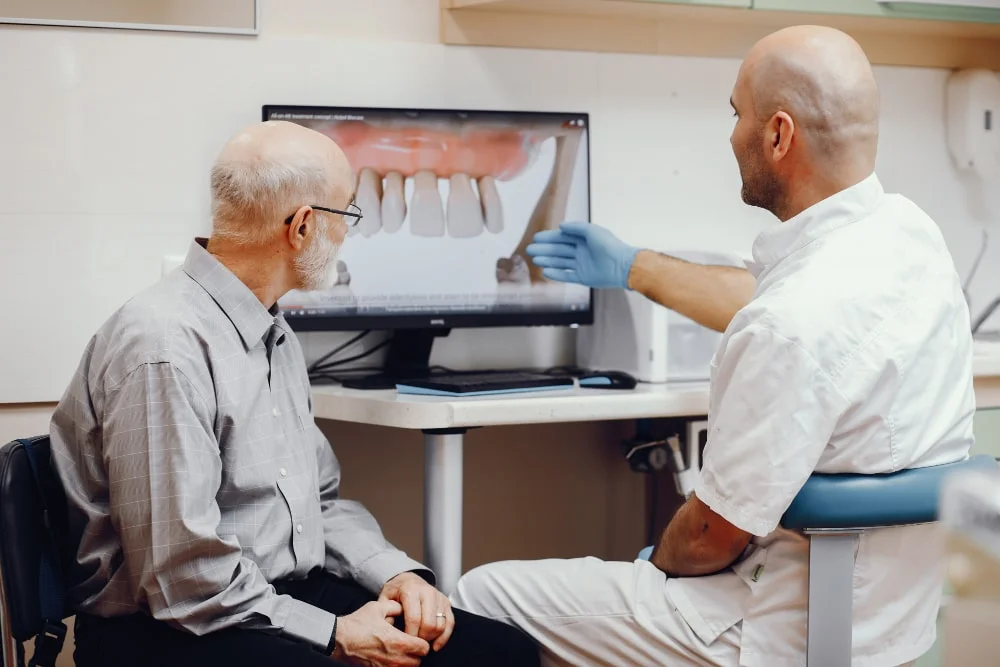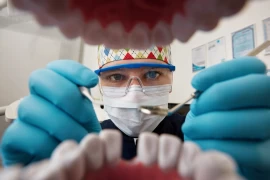
Implant Approach in Osteoporotic Patients
- Implant Approach in Osteoporotic Patients
- What Is Osteoporosis and How Is It Related to Oral Health?
- Systemic Evaluation Is the First Step in Implant Planning
- Bisphosphonate and Denosumab Use: Points of Caution
- Considerations in Surgical Planning
- Healing Process and Follow-Up
- Patient Communication Process
- In Conclusion…
As a periodontist, I always consider the systemic health status of the patient when making clinical decisions regarding dental implants. When it comes to patients with osteoporosis, I adopt a much more sensitive and cautious approach in treatment planning. In this article, I would like to share in detail my approach to dental implant applications in individuals with osteoporosis, based on scientific data and my clinical experience.
What Is Osteoporosis and How Is It Related to Oral Health?
Osteoporosis is a systemic disease characterized by a decrease in bone mass and deterioration of bone microarchitecture, which increases the fragility of bones. Although it most commonly causes fractures in areas such as the hip, spine, and wrist, it can also affect maxillofacial regions like the jawbone.
The jawbones, especially the alveolar bone, have a dynamic structure. The effects of osteoporosis on the alveolar bone include decreased bone density, thinning of the trabecular structure, and cortical bone reduction. This can weaken the supporting tissues of the teeth and lead to tooth loss. At this point, when patients request implants, it becomes essential to thoroughly evaluate their systemic condition.
Systemic Evaluation Is the First Step in Implant Planning
Before proceeding with implant planning in a patient diagnosed with osteoporosis, the first step is to analyze the severity of the disease, the medications used, any accompanying systemic conditions, and lifestyle factors in detail. The key factors I pay special attention to include:
- Bone Mineral Density (BMD) measurement: A T-score below -2.5 indicates reduced bone quality. However, this alone is not a contraindication for implant treatment.
- Use of bisphosphonates or denosumab: These medications reduce bone resorption by suppressing osteoclast activity. However, with long-term use, they pose a risk of osteonecrosis, so surgical interventions must be approached cautiously.
- Smoking, duration of menopause, and hormonal treatments must also be questioned, as they significantly affect bone health.
Bisphosphonate and Denosumab Use: Points of Caution
Oral bisphosphonates, which are among the most frequently used agents in the treatment of osteoporosis, can significantly impact implant success. These drugs bind to the bone surface and inhibit osteoclasts, halting the bone remodeling process. This delays healing after surgery and, although rare, can cause serious complications such as medication-related osteonecrosis of the jaw (MRONJ).
My approach is as follows:
- If oral bisphosphonate use is < 3 years and there are no additional risk factors, implant surgery is generally safe. However, it is essential to inform the patient and obtain written consent.
- If the patient has been using bisphosphonates for more than 3 years or has received intravenous bisphosphonate therapy, I avoid implant surgery or decide only after multidisciplinary consultation.
- For patients on denosumab (Prolia), considering its effects last about 6 months, I plan the surgery approximately in the 5th month after injection. However, this must also be done in consultation with the relevant specialist.

Considerations in Surgical Planning
Bone quality is crucial in implant surgery. In osteoporotic patients, low bone density can make it difficult to achieve primary stability. Therefore:
- I prefer conical design implants with specially roughened surfaces.
- When necessary, I prepare a narrower surgical socket to ensure a tighter fit for the implant.
- Bone grafting should be considered, especially in the posterior regions, as a supportive measure.
- Advanced surgical techniques such as sinus lifting may be required, but these demand even more precision in osteoporotic bone.
Healing Process and Follow-Up
In patients with osteoporosis, the healing process may take longer compared to healthy individuals. For this reason:
- I extend the osseointegration period from 2–3 months to 4–6 months.
- To support soft tissue healing, I recommend local hygiene protocols, antiseptic mouthwashes, and, when necessary, antibiotic prophylaxis.
- I perform regular clinical and radiographic follow-ups to monitor implant stability.
Patient Communication Process
After explaining the general benefits of implant treatment to my patients, I make sure to inform them that, as osteoporosis patients, their risk of complications may be higher. Although the success rate of this treatment is quite high with proper patient selection and surgical techniques, the effects of medications and bone metabolism must be taken into account. This communication process is very important both ethically and legally.
In Conclusion…
Implant applications in osteoporotic patients can yield highly successful results with proper planning and careful surgery. As a periodontist, I evaluate numerous parameters such as the patient’s general health condition, bone quality, and medication history to create a personalized treatment plan.
My goal is to offer an implant treatment that meets the patient’s functional and aesthetic needs while preserving their long-term health. We must always remember that every patient is unique, and the treatment plan must be individualized.
Thank you for your attention.

Prof. Dr. Elif Eser ACAREL
Specialist in Periodontology




